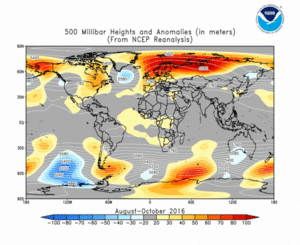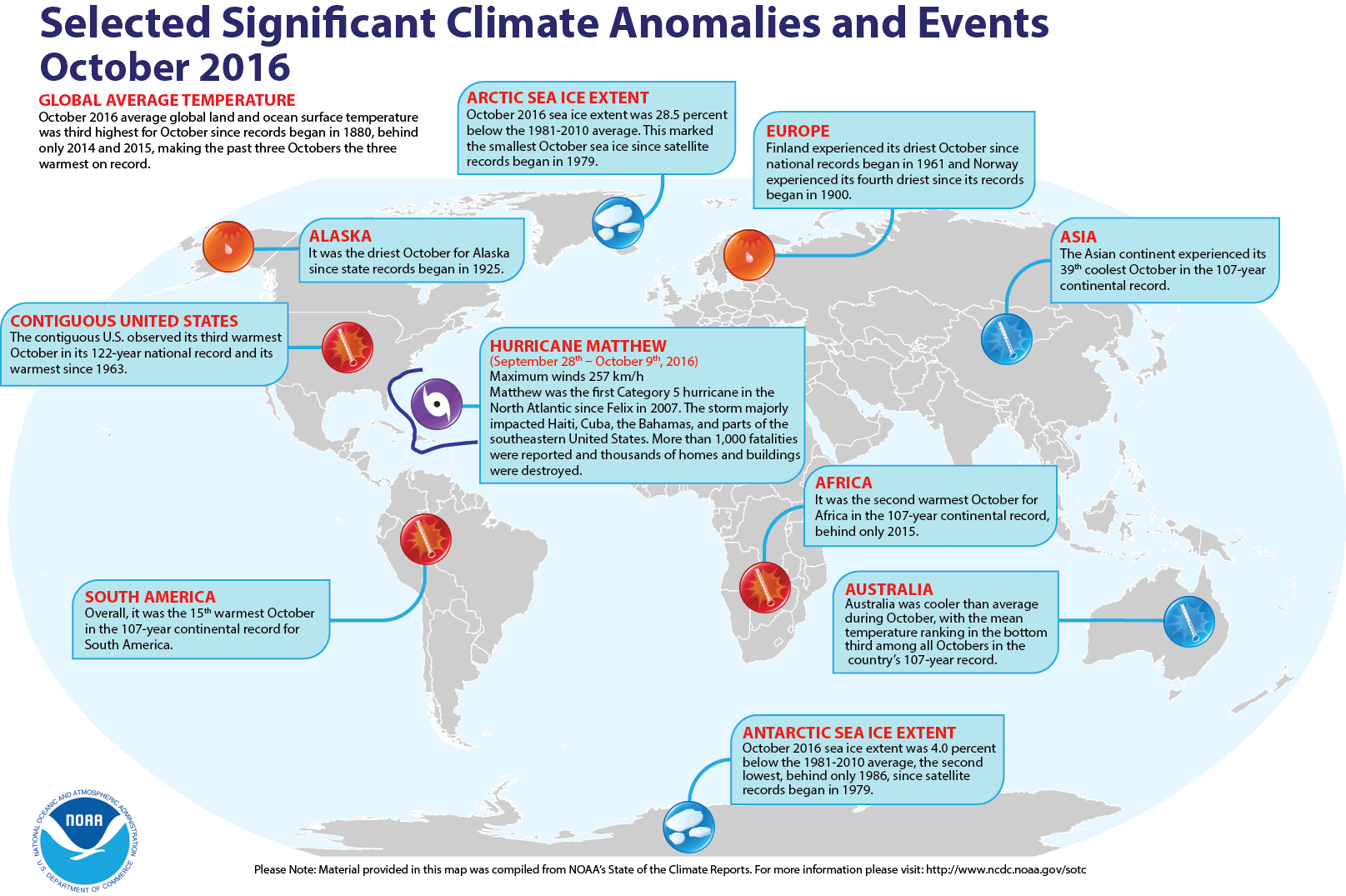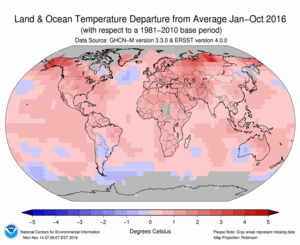Introduction
Temperature anomalies and percentiles are shown on the gridded maps below. The anomaly map on the left is a product of a merged land surface temperature (Global Historical Climatology Network, GHCN) and sea surface temperature (ERSST.v4) anomaly analysis as described in Huang et al. (2016). Temperature anomalies for land and ocean are analyzed separately and then merged to form the global analysis. For more information, please visit NCEI's Global Surface Temperature Anomalies page. The percentile map on the right provides additional information by placing the temperature anomaly observed for a specific place and time period into historical perspective, showing how the most current month, season or year compares with the past.
Temperatures
In the atmosphere, 500-millibar height pressure anomalies correlate well with temperatures at the Earth's surface. The average position of the upper-level ridges of high pressure and troughs of low pressure—depicted by positive and negative 500-millibar height anomalies on the  October 2016 and
October 2016 and  August–October 2016 maps—is generally reflected by areas of positive and negative temperature anomalies at the surface, respectively.
August–October 2016 maps—is generally reflected by areas of positive and negative temperature anomalies at the surface, respectively.
October
The combined average temperature over global land and ocean surfaces for October 2016 tied with 2003 as the third highest for October in the 137-year period of record, at 0.73°C (1.31°F) above the 20th century average of 14.0°C (57.1°F). This is 0.26°C (0.47°F) cooler than the record warmth of October 2015 when El Niño conditions were strengthening and 0.50°C (0.90°F) cooler than the all-time record warmth of March 2016 when the El Niño was near the end of its peak. Including 2016, the past three Octobers have been the three warmest in the historical record; however, October 2016 also marked the lowest monthly departure from average for any month since November 2014, which was 0.69°C (1.24°F) above average.
The average global temperature across land surfaces was 0.76°C (1.37°F) above the 20th century average of 9.3°C (48.7°F)—the 16th highest October global land temperature on record but also the lowest October value since 2002, when the departure from average was +0.49°C (+0.88°F).
Warmer- to much-warmer-than-average conditions were present across large areas of the world's land surface, with record warmth across parts of Mexico and the Caribbean, parts of west central Africa, sections of southeastern Asia, western Alaska extending to Far East Russia, where temperatures were more than 5°C (9°F) above their 1981–2010 averages, according to the Land & Ocean Temperature Percentiles map above. Cooler- and much-cooler-than-average conditions were observed much of western Canada, most of eastern Europe, and a large swath extending across much of central Asia, where temperatures were more than 5°C (9°F) above below their 1981–2010 averages in places. No land areas experienced record cold temperatures during October 2016. According to NCEI's Global Regional analysis, Africa as a whole observed its second warmest October on record, behind only 2015, while North America had its seventh warmest. Asia observed its 39th coolest October in the 107-year continental record.
Select national information is highlighted below. Please note that different countries report anomalies with respect to different base periods. The information provided here is based directly upon these data:
- Due primarily to a very warm start to the month, Quebec, Canada, observed October anomalies 2–3°C (4–5°F) higher than average for the month.
- Australia was cooler than average during October, with the mean temperature ranking in the bottom third (0.50°C / 0.90°F below its 1961–1990 average) among all Octobers in a series dating to 1910. The minimum temperature was the 20th lowest for October, at 0.73°C (1.31°F) below average. The below-average temperatures were widespread across the country: every state was cooler than average for the month, with the exception of Western Australia, which was 0.33°C (0.59°F) warmer than its 1961–1990 average.
- With a national temperature 0.4°C (0.7°F) below the 1981–2010 average, October 2016 was the coolest month for Austria with respect to its average since August 2014, when the temperature was 1.1°C (2.0°F) below its monthly average. The "gloomiest" October since 1998 across the country contributed to the below-average temperature, according to ZAMG.
- Parts of Greenland, including the eastern coast and Camp Summit, were record warm in October, with several stations reporting new monthly high temperatures. Among the largest departures, Daneborg was 7.4°C (13.3°F) warmer than its 1981–2010 average with a record dating to 1958, while Summit, at the top of the Greenland ice sheet with a record to 1991, was 7.3°C (13.1°F) above average.
For the oceans, the October globally-averaged sea surface temperature was 0.72°C (1.30°F) above the 20th century average of 15.9°C (60.6°F), the second highest for October on record, behind 2015 by 0.14°C (0.25°F). Including 2016, the past five Octobers (2012–2016) have had the five highest October global ocean temperatures in the 137-year record.
Most of the world's oceans experienced warmer- to much-warmer-than-average temperatures during October 2016, with record warmth present across parts of the southern and western Pacific, the Caribbean Sea, small areas of the Southern Ocean, a vertical swath of the western Atlantic extending south from the northeastern United States, and parts of the Arctic Seas. Cooler- and much-cooler-than-average conditions were limited to the Indian Ocean waters off southwestern Australia, part of the north central Atlantic, and small areas of the central and South Pacific.
La Niña conditions prevailed during October 2016, with below-average temperatures across the eastern tropical Pacific Ocean. According to NOAA's Climate Prediction Center there is a 55 percent chance La Niña will persist through the Northern Hemisphere winter 2016/17. This forecast focuses on the ocean surface temperatures between 5°N and 5°S latitude and 170°W to 120°W longitude, called the Niño 3.4 region.
| October | Anomaly | Rank (out of 137 years) | Records | ||||
|---|---|---|---|---|---|---|---|
| °C | °F | Year(s) | °C | °F | |||
| Global | |||||||
| Land | +0.76 ± 0.14 | +1.37 ± 0.25 | Warmest | 16th | 2015 | +1.35 | +2.43 |
| Coolest | 122nd | 1912 | -0.95 | -1.71 | |||
| Ocean | +0.72 ± 0.15 | +1.30 ± 0.27 | Warmest | 2nd | 2015 | +0.86 | +1.55 |
| Coolest | 136th | 1908, 1909 | -0.46 | -0.83 | |||
| Land and Ocean | +0.73 ± 0.14 | +1.31 ± 0.25 | Warmest | 3rd | 2015 | +0.99 | +1.78 |
| Coolest | 135th | 1908, 1912 | -0.52 | -0.94 | |||
| Ties: 2003 | |||||||
| Northern Hemisphere | |||||||
| Land | +0.75 ± 0.11 | +1.35 ± 0.20 | Warmest | 16th | 2011 | +1.34 | +2.41 |
| Coolest | 122nd | 1912 | -1.22 | -2.20 | |||
| Ties: 2004 | |||||||
| Ocean | +0.85 ± 0.14 | +1.53 ± 0.25 | Warmest | 3rd | 2015 | +1.04 | +1.87 |
| Coolest | 135th | 1908 | -0.53 | -0.95 | |||
| Land and Ocean | +0.81 ± 0.15 | +1.46 ± 0.27 | Warmest | 6th | 2015 | +1.13 | +2.03 |
| Coolest | 132nd | 1912 | -0.73 | -1.31 | |||
| Ties: 2008 | |||||||
| Southern Hemisphere | |||||||
| Land | +0.80 ± 0.18 | +1.44 ± 0.32 | Warmest | 14th | 2015 | +1.55 | +2.79 |
| Coolest | 124th | 1910 | -0.80 | -1.44 | |||
| Ocean | +0.63 ± 0.15 | +1.13 ± 0.27 | Warmest | 2nd | 2015 | +0.73 | +1.31 |
| Coolest | 136th | 1909 | -0.42 | -0.76 | |||
| Land and Ocean | +0.65 ± 0.14 | +1.17 ± 0.25 | Warmest | 3rd | 2015 | +0.86 | +1.55 |
| Coolest | 135th | 1910 | -0.47 | -0.85 | |||
| Ties: 1997, 2012 | |||||||
| Arctic | |||||||
| Land and Ocean | +1.54 ± 0.37 | +2.77 ± 0.67 | Warmest | 7th | 1947 | +1.79 | +3.22 |
| Coolest | 131st | 1912 | -1.65 | -2.97 | |||
The most current data can be accessed via the Global Surface Temperature Anomalies page.
Year-to-date (January–October)
With two months remaining, the 2016 year-to-date global temperature (January–October) was the highest for this period on record, at 0.97°C (1.75°F) above the 20th century average of 14.1°C (57.4°F). This value exceeds the previous record set in 2015 by 0.10°C (0.18°F).
Much-warmer-than-average conditions engulfed the vast majority of the world's land surfaces, resulting in a record warm January–October period at 1.48°C (2.66°F) above the 20th century average, besting the previous record set in 2015 by 0.19°C (0.34°F). Record warmth for the January–October period was observed across the Caribbean and part of Central America, much of northern and northeastern South America, large parts of Africa in the western, eastern, and southern areas of the continent, Alaska and Far East Russia, parts of northern Russia and central Asia, most of the southeastern Asian island nations, and eastern Australia. Notably, no land areas were cooler than average for the year-to-date. According to NCEI's Global Regional analysis, all six continents had at least a top three warm January–October period, with North America and Asia each experiencing a record high average temperature for that period since continental records began in 1910.
The average global sea surface temperature for the year-to-date was the highest in the 137-year period of record, at 0.77°C (1.39°F) above average, surpassing the previous record set in 2015 by 0.05°C (0.09°F). Record warm sea surface temperatures during January–October 2016 were present across parts of the southern equatorial Pacific, the northeastern Pacific waters off the Alaskan coast, parts of the western North Atlantic and eastern South Atlantic near Africa, regions of the southern and eastern Indian Ocean. The only ocean area with record cold and much-cooler-than-average temperatures was east of the Drake Passage off the southern tip of South America in the Scotia Sea.
| January–October | Anomaly | Rank (out of 137 years) | Records | ||||
|---|---|---|---|---|---|---|---|
| °C | °F | Year(s) | °C | °F | |||
| Global | |||||||
| Land | +1.48 ± 0.16 | +2.66 ± 0.29 | Warmest | 1st | 2016 | +1.48 | +2.66 |
| Coolest | 137th | 1893 | -0.64 | -1.15 | |||
| Ocean | +0.77 ± 0.18 | +1.39 ± 0.32 | Warmest | 1st | 2016 | +0.77 | +1.39 |
| Coolest | 137th | 1911 | -0.47 | -0.85 | |||
| Land and Ocean | +0.97 ± 0.17 | +1.75 ± 0.31 | Warmest | 1st | 2016 | +0.97 | +1.75 |
| Coolest | 137th | 1904, 1911 | -0.47 | -0.85 | |||
| Northern Hemisphere | |||||||
| Land | +1.65 ± 0.18 | +2.97 ± 0.32 | Warmest | 1st | 2016 | +1.65 | +2.97 |
| Coolest | 137th | 1884 | -0.70 | -1.26 | |||
| Ocean | +0.88 ± 0.17 | +1.58 ± 0.31 | Warmest | 1st | 2016 | +0.88 | +1.58 |
| Coolest | 137th | 1904 | -0.49 | -0.88 | |||
| Land and Ocean | +1.17 ± 0.17 | +2.11 ± 0.31 | Warmest | 1st | 2016 | +1.17 | +2.11 |
| Coolest | 137th | 1904 | -0.51 | -0.92 | |||
| Southern Hemisphere | |||||||
| Land | +1.06 ± 0.14 | +1.91 ± 0.25 | Warmest | 1st | 2016 | +1.06 | +1.91 |
| Coolest | 137th | 1917 | -0.68 | -1.22 | |||
| Ocean | +0.70 ± 0.18 | +1.26 ± 0.32 | Warmest | 1st | 2016 | +0.70 | +1.26 |
| Coolest | 137th | 1911 | -0.48 | -0.86 | |||
| Land and Ocean | +0.76 ± 0.17 | +1.37 ± 0.31 | Warmest | 1st | 2016 | +0.76 | +1.37 |
| Coolest | 137th | 1911 | -0.51 | -0.92 | |||
| Arctic | |||||||
| Land and Ocean | +2.15 ± 0.14 | +3.87 ± 0.25 | Warmest | 1st | 2016 | +2.15 | +3.87 |
| Coolest | 137th | 1888 | -1.06 | -1.91 | |||
The most current data can be accessed via the Global Surface Temperature Anomalies page.
Precipitation
October
The maps below represent precipitation percent of normal (left, using a base period of 1961–1990) and precipitation percentiles (right, using the period of record) based on the GHCN dataset of land surface stations. As is typical, precipitation anomalies during October 2016 varied significantly around the world. October precipitation was notably drier than normal across the southeastern United States, eastern Brazil, northern and eastern Europe, western, southern, and coastal northern Africa, Turkey, Pakistan, southern India, and central Siberia. Wetter-than-normal conditions were present across the northwestern United States, much of Argentina, eastern Europe, and parts of Mongolia and eastern China.
Select national information is highlighted below. (Please note that different countries report anomalies with respect to different base periods. The information provided here is based directly upon these data):
- It was dry across much of northern Europe. Finland observed its driest October in the country's 55-year period of record. The driest regions were in the west and north, with total precipitation generally between 5 and 20 mm. Norway reported its fourth driest October since its national record began in 1900. Averaged across the country, precipitation was just 45 percent of normal. Some stations, primarily in Oppland and Hedmark, received less than 10 perecent of their normal rainfall.
- The United Kingdom reported its sixth driest October in its 107-year record, with just 38 percent of typical rainfall for the month.
References
- Peterson, T.C. and R.S. Vose, 1997: An Overview of the Global Historical Climatology Network Database. Bull. Amer. Meteorol. Soc., 78, 2837-2849.
- Huang, B., V.F. Banzon, E. Freeman, J. Lawrimore, W. Liu, T.C. Peterson, T.M. Smith, P.W. Thorne, S.D. Woodruff, and H-M. Zhang, 2016: Extended Reconstructed Sea Surface Temperature Version 4 (ERSST.v4). Part I: Upgrades and Intercomparisons. J. Climate, 28, 911-930.
 NOAA's National Centers for Environmental Information
NOAA's National Centers for Environmental Information










